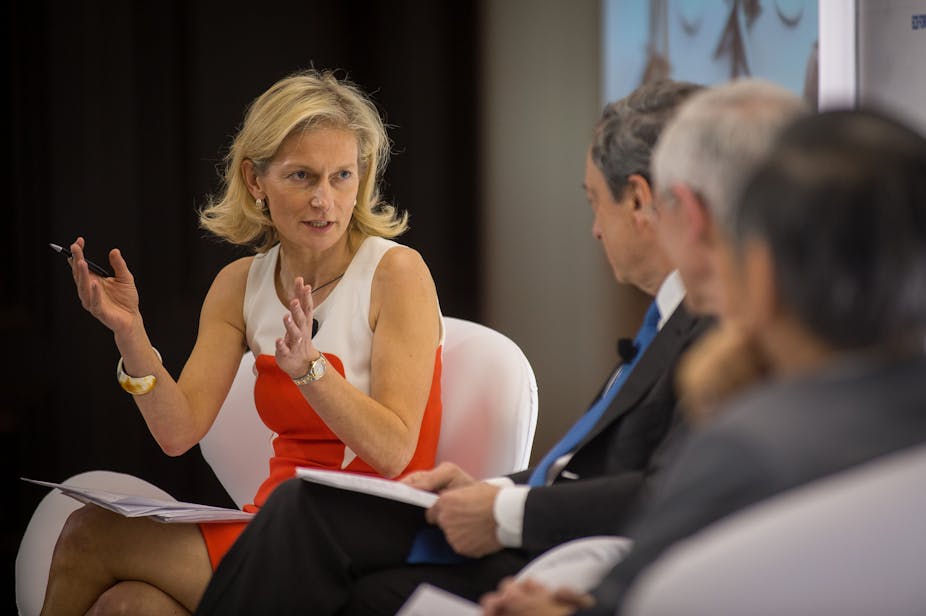It has been a momentous year for women in media. In March, The Guardian announced Katherine Viner would become the next editor-in-chief, the first woman to take on this role in the newspaper’s 194-year history. A few months earlier, The Economist, with its 171-year-history similarly introduced its first female editor-in-chief when they appointed Zanny Minton Beddoes.
BBC Radio 4 recently released its Woman’s Hour Power List of “women who have an exceptionally large impact on our lives”. Both Viner and Minton Beddoes were on it.
Two world-leading publications, two women at its helm – women must surely be making major progress in the fight for gender equality. Or are they?
Hierarchies of news
While in no way do I want to diminish the accomplishments of Viner and Minton Beddoes, it remains less clear what impact these appointments will have in newsrooms across the world, or what impact this will have on the type of news produced, and the gender of those producing it.
After all, within the British context, which is made up of 23 daily or Sunday newspapers, roughly 1,200 regional or local papers, and more than 1,400 associated websites, only a fraction are edited by women. According to a recent report on the status of women in the news media by the International Women’s Media Foundation, men occupy the vast majority of the management jobs and news-gathering positions in most nations. The study found 73% of the top management jobs are occupied by men compared to 27% occupied by women. Among the ranks of reporters, men hold nearly two-thirds of the jobs, compared to 36% held by women.
These figures, which have remained fairly static over time, show the ways that women still have a long way to go in achieving equality. At lower levels, however, women seem to be doing much better – in theory at least. While those who work in the more administrative roles are necessary for the smooth running of any newsroom, such posts are often clerical in nature, and confirm the ways women may enter the news industries, but remain within “ghettos of employment” once there.
There remain gendered differences in the types of stories women cover. Global research shows that men write 67% of stories about politics and government, 65% of stories about crime and violence and 60% of stories about the economy.
Within the hierarchies of news, these “hard” stories are seen as more prestigious and more likely to be found in the first few pages of the newspaper, while “softer” genres such as entertainment, health and lifestyle, which women mostly report, tend to be buried later in the papers.
Gendered nature of news
When it comes to news content, as British academic Karen Ross noted, “what we see, read and hear is mostly news about men”.
In fact, only around one quarter of all people heard, read or seen in the news are women and these figures have hardly changed over the past 15 years. It’s not just statistics which speak to the gendered nature of news. Interviews with journalists in Australia and UK reveal the ways that the newsrooms are “blokey” spaces. Here, a “mates” mentality works to keep women out of certain beats, stories and positions.
These studies also point to the fact that sexual harassment is rife and just seen as part of the job. It is therefore no surprise that women leave the profession in droves, or that women in the industry tend to be younger and single compared to their male counterparts. Interviews with those who have left indicate they leave as a combination of sexism, discrimination and the way the industry is not ideal for family life.
On the other hand, many go freelance – an option which promises flexibility in making one’s own schedule in theory – but which in reality leaves many women without stability, benefits, paid vacations or pension plans.

Who produces news matters
All of this is not to say the appointment of Viner and Minton Beddoes cannot, or will not, have an impact. After all, having women in leadership positions can send a very strong message to those within the organisation about women’s capabilities, aspirations and ambitions.
That being said, throughout time and across various industries, having a woman at the top does not necessarily mean she will champion other women (think Margaret Thatcher). But to the question of does it matter that the the Guardian and the Economist have appointed women to head these important publications, I can only say it does.
It matters very much who produces the news. And the lack of women in the news industries, particularly at senior levels, sends an important message to the public about women’s place, their roles and their lives – namely that they are not important, they do not matter, or are not capable of performing this role. This is something I hope the appointment of these two senior women challenges, and that they take it upon themselves to institute change from the top-down.

